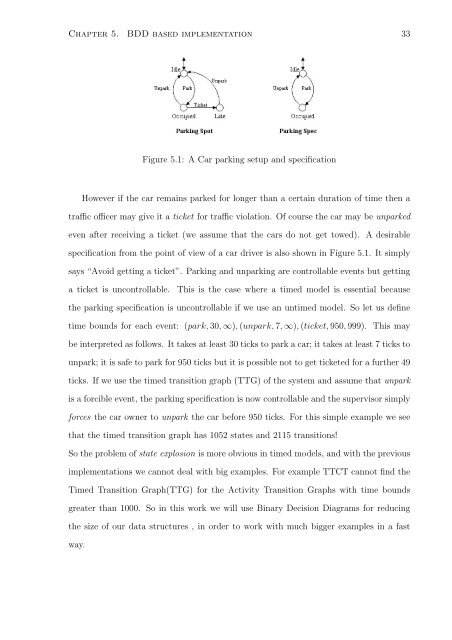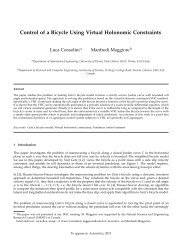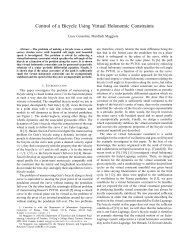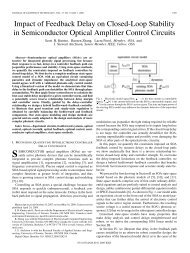State Based Control of Timed Discrete Event Systems using Binary ...
State Based Control of Timed Discrete Event Systems using Binary ...
State Based Control of Timed Discrete Event Systems using Binary ...
Create successful ePaper yourself
Turn your PDF publications into a flip-book with our unique Google optimized e-Paper software.
Chapter 5. BDD based implementation 33Figure 5.1: A Car parking setup and specificationHowever if the car remains parked for longer than a certain duration <strong>of</strong> time then atraffic <strong>of</strong>ficer may give it a ticket for traffic violation. Of course the car may be unparkedeven after receiving a ticket (we assume that the cars do not get towed). A desirablespecification from the point <strong>of</strong> view <strong>of</strong> a car driver is also shown in Figure 5.1. It simplysays “Avoid getting a ticket”. Parking and unparking are controllable events but gettinga ticket is uncontrollable.This is the case where a timed model is essential becausethe parking specification is uncontrollable if we use an untimed model. So let us definetime bounds for each event: (park, 30, ∞), (unpark, 7, ∞), (ticket, 950, 999). This maybe interpreted as follows. It takes at least 30 ticks to park a car; it takes at least 7 ticks tounpark; it is safe to park for 950 ticks but it is possible not to get ticketed for a further 49ticks. If we use the timed transition graph (TTG) <strong>of</strong> the system and assume that unparkis a forcible event, the parking specification is now controllable and the supervisor simplyforces the car owner to unpark the car before 950 ticks. For this simple example we seethat the timed transition graph has 1052 states and 2115 transitions!So the problem <strong>of</strong> state explosion is more obvious in timed models, and with the previousimplementations we cannot deal with big examples. For example TTCT cannot find the<strong>Timed</strong> Transition Graph(TTG) for the Activity Transition Graphs with time boundsgreater than 1000. So in this work we will use <strong>Binary</strong> Decision Diagrams for reducingthe size <strong>of</strong> our data structures , in order to work with much bigger examples in a fastway.







